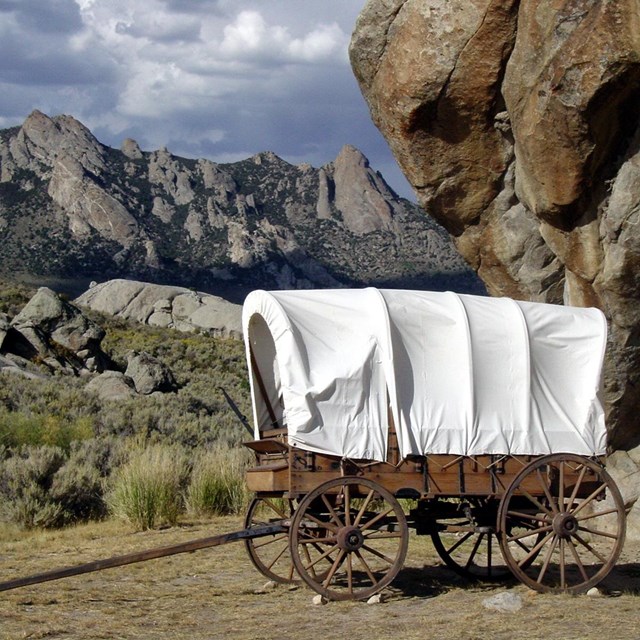Lasting Impression. 514 words.
This graphic panel sits at the edge of the pull-off along the road, which lies to the left as you face the panel. The pull-off is behind you. To the right of the panel is a rocky outcropping. To the left of the panel is a vertical railroad rail which is a trail marker. The ground in front of you rises up a grassy slope. There are more rock outcrops up the slope on the left and small trees scattered to the right. Directly in front of you is a worn trail or ruts going up the slope.
The background of this panel has a photograph of the view of the slope in front of you. Superimposed on the photograph are images of a line of three covered wagons moving up the slope.
Text on the panel reads, "The ruts on the hill before you are some of the best remaining physical evidence of the Applegate Trail. This wagon route led Euro-American immigrants to the Willamette Valley from the south, along a California Trail connector. Beginning in 1846 and continuing into the 1850s, thousands of people and wagons followed this route north. Their wheels cut into the bedrock. In 1853, prospectors began flooding the hills and river valleys in search of gold.
"The Cow Creek Umpqua Tribe has lived in this area since time immemorial. They have a deep culture and commitment to preserving their way of life by managing their natural resources. With immigrants came epidemics, depleted resources, and efforts to remove the Cow Creek Umpqua from their lands. The Cow Creek Umpqua are a resilient people that remain strong, but will always carry the impact of this trail's legacy as part of their history."
At bottom right on the panel is a small map showing the southern half of Oregon and parts of northern California and Nevada. An irregular tan-colored shape stretching from the California border to just south of Eugene marks the Cow Creek Umpqua Ancestral Territory with your current location near the middle. A red line marks the path of the California National Historic Trail. It comes up through Nevada to the northeast corner of California. There it splits. One branch turns back south into California. The other branch continues west and turns north towards Eugene, passing through the Cow Creek Umpqua territory. This branch is the Applegate Trail, established 1846. A caption below the map reads, "The ancestral territory of the Cow Creek Umpqua encompassed much of what is today western Oregon. The Applegate Trail cut through their lands, leading emigrants to the Willamette Valley, while avoiding the hazards of crossing the Columbia River."
Across the top of the panel is a black bar. At the left end text reads "Myrtle Creek." At the right end is the logo and text for California National Historic Trail. Other text reads, "City of Myrtle Creek, Oregon; Cow Creek Band of Umpqua Tribe; National Park Service."
At bottom left is a QR code and the Audio Description symbol. Text reads, "For audio description of this wayside visit go.nps.gov/LastingImpression."
End of Description.



